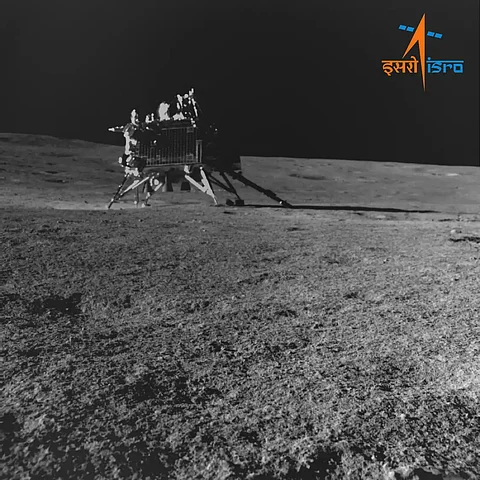

Buried beneath the Moon’s surface, hidden reserves of water ice may be more abundant than once believed. Fresh findings from India’s Chandrayaan-3 mission suggest that future astronauts could one day tap into this frozen resource — not just for drinking water, but to cool equipment, produce oxygen and even fuel deep-space exploration.
The Indian Space Research Organisation’s (ISRO) Chandrayaan-3 successfully soft-landed near the Moon’s south pole on August 23, 2023. The study, published in the journal Communications Earth & Environment, is based on data gathered by Chandra’s Surface Thermophysical Experiment (ChaSTE), a payload aboard Vikram, the mission’s lander module.
ChaSTE was designed to measure the thermal conductivity and temperature of the lunar surface.
The payload conducted surface measurements near the landing site, providing temperature readings for the top 10 centimetres of regolith and assessing the thermal conductivity of a high-latitude location in the Moon’s southern polar region. Regolith refers to the layer of rock fragments covering the exposed surfaces of airless celestial bodies, such as the Moon.
“ChaSTE experiment onboard Vikram lander of Chandrayaan-3 has provided the first in-situ temperature profiles near south polar region of the Moon, as per the best of our knowledge,” researchers from India wrote in the study. Previous such measurements were available only from equatorial regions where NASA’s Apollo missions landed, they added.
The study highlighted that the local thermophysical environment plays a key role in determining the presence and stability of water ice on the Moon. The ChaSTE experiment aimed to explore these environmental factors at the landing site to better understand the conditions that allow water ice to remain stable at or beneath the surface.
Indian researchers worked on the design and development of ChaSTE and mission operations following Vikram lander's soft landing.
The presence and stability of water-ice on the Moon are controlled by the local thermophysical environment, according to earlier research. In order to better understand the factors that made water ice stable at the surface or below, ChaSTE set out to investigate the local thermophysical environment at the landing site.
Earlier studies had indicated that surface temperatures between -163.15 degrees Celsius and -159.15°C are conducive to the presence of water ice, particularly in polar regions. Researchers also hypothesised that water ice could migrate into the subsurface.
ChaSTE began recording data on the second day after landing and continued measurements until September 2, 2023, piercing the lunar soil to assess temperature variations.
The results showed that temperatures near the lunar south pole were unexpectedly high. The Sun-facing slope at an angle of 6° peaked at 82°C and dropped to -168°C during the lunar night. Meanwhile, a flat region roughly one metre from the lander recorded a lower peak temperature of 59°C.
“The higher temperatures measured at this high latitude location were quite surprising, although our pre-landing estimates predicted higher temperatures. However, we did not anticipate that surface temperatures can show significant variability within metre scales.
This is completely a new insight about temperatures and thermophysics on the Moon and needs more detailed investigations in future,” K Durga Prasad, faculty and principle investigator of ChaSTE (PRL), Planetary Sciences Division at the Physical Research Laboratory, told Down To Earth.
ChaSTE observations indicate that much higher surface temperatures make water ice on the surface unstable. However, the study offers hope. The presence of water ice is likely influenced by slopes and sun exposure, which affect temperatures and thermophysical conditions.
Based on the payload’s observation of high temperatures due to a sunward slope of approximately 6°, researchers modelled the solar flux and diurnal temperature variations at different slope angles and aspect angles.
Poleward slopes greater than 14-18° experience significantly lower surface temperatures, creating conditions more favourable for water ice accumulation within the subsurface, Prasad explained.
Sunward slopes are unlikely to support stable water ice, whereas steeper poleward slopes (exceeding 14°) offer a more suitable environment.
At a 14° slope, models predict maximum and minimum temperatures of -37.15°C and -199.15°C, suggesting that water ice could remain stable at a depth of up to one metre. At an 18° slope, maximum and minimum temperatures of -120.15°C and -206.15°C indicate that water ice might even be stable at the surface and subsurface within a metre.
ChaSTE observations further revealed that sun-facing slopes are significantly warmer, whereas nearby poleward-facing slopes just a metre apart could be much cooler, providing an environment conducive to the presence of water ice within the shallow subsurface.
“The ChaSTE measurements provide a lot of new information about the temperature distribution within the outermost 10 cm regolith layer of lunar high-latitude highlands,” the researchers wrote in the study.
These high-latitude regions are promising locations for water ice prospecting, resource utilisation and human habitation, they explained. Furthermore, such sites pose fewer technical challenges for exploration compared with areas closer to the Moon’s poles, making them more accessible.
Looking ahead, researchers aim to survey different locations for the presence and quantity of water ice. They also call for a deeper understanding of the lunar water cycle and its spatial and temporal variations, which could aid in future human and robotic exploration efforts.